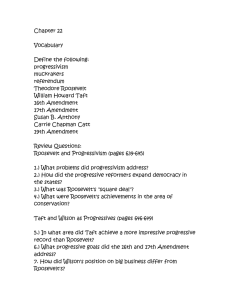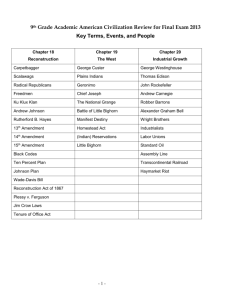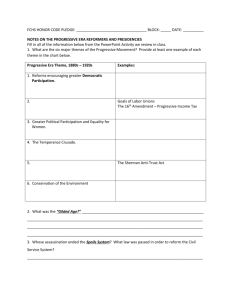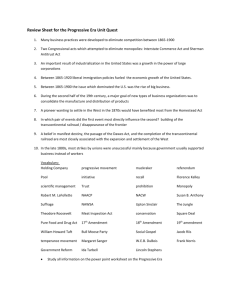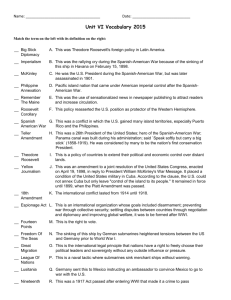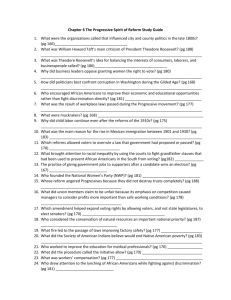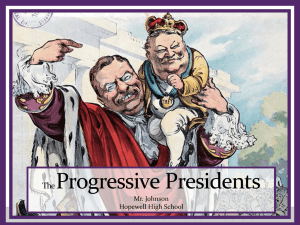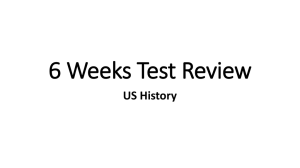THE PROGRESSIVE ERA EXAM
advertisement
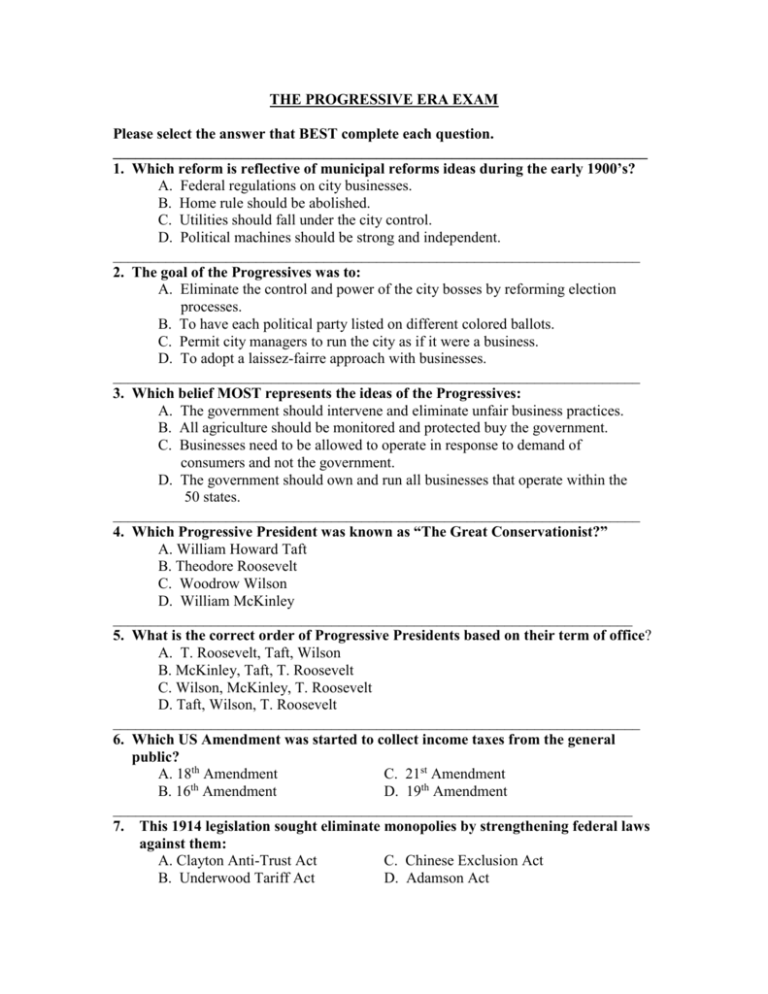
THE PROGRESSIVE ERA EXAM Please select the answer that BEST complete each question. _______________________________________________________________________ 1. Which reform is reflective of municipal reforms ideas during the early 1900’s? A. Federal regulations on city businesses. B. Home rule should be abolished. C. Utilities should fall under the city control. D. Political machines should be strong and independent. ______________________________________________________________________ 2. The goal of the Progressives was to: A. Eliminate the control and power of the city bosses by reforming election processes. B. To have each political party listed on different colored ballots. C. Permit city managers to run the city as if it were a business. D. To adopt a laissez-fairre approach with businesses. ______________________________________________________________________ 3. Which belief MOST represents the ideas of the Progressives: A. The government should intervene and eliminate unfair business practices. B. All agriculture should be monitored and protected buy the government. C. Businesses need to be allowed to operate in response to demand of consumers and not the government. D. The government should own and run all businesses that operate within the 50 states. ______________________________________________________________________ 4. Which Progressive President was known as “The Great Conservationist?” A. William Howard Taft B. Theodore Roosevelt C. Woodrow Wilson D. William McKinley _____________________________________________________________________ 5. What is the correct order of Progressive Presidents based on their term of office? A. T. Roosevelt, Taft, Wilson B. McKinley, Taft, T. Roosevelt C. Wilson, McKinley, T. Roosevelt D. Taft, Wilson, T. Roosevelt ______________________________________________________________________ 6. Which US Amendment was started to collect income taxes from the general public? A. 18th Amendment C. 21st Amendment th B. 16 Amendment D. 19th Amendment _____________________________________________________________________ 7. This 1914 legislation sought eliminate monopolies by strengthening federal laws against them: A. Clayton Anti-Trust Act C. Chinese Exclusion Act B. Underwood Tariff Act D. Adamson Act _______________________________________________________________________ 8. In 1906, Teddy Roosevelt and Congress enacted federal laws to protect the consumer. This act was passed to ensure the quality of meat prior to consumption. What was it called? A. The Meat and Drug Act B. The Meat Inspection Act C. Government Regulations Act D. Mann-Elkins Act. ______________________________________________________________________ 9. In 1906, Teddy Roosevelt and Congress enacted federal laws to protect the consumer. This act was passed to ensure the quality of food and medication prior to consumption. What was it called? A. The Meat and Drug Act B. The Pure Food and Drug Act C. Government Regulations Act D. Mann-Elkins Act. ______________________________________________________________________ 10. Which Progressive President favored the government running the banking system to ensure stability and fairness? A. William Howard Taft B. Theodore Roosevelt C. Woodrow Wilson D. William McKinley ______________________________________________________________________ 11. The muckrakers wrote numerous articles to generate public support for: A. Taft’s decision in the Ballinger-Pinchot Affair. B. The passing of the 16th Amendment. C. the creation of the Federal reserve System. D. Roosevelt’s plan to expand regulatory powers of the federal government. _______________________________________________________________________ 12. This act required a company to advertise the make-up of a product on its label. This was required by: A. 16th Amendment B. Pure Food and Drug Act C. Government Regulation Act D. Meat Inspection Act ______________________________________________________________________ 13. What Progressive reform allows a voter to remove an elected official from office? A. Referendum C. Recall B. Australian Ballot D. Initiative ________________________________________________________________________ _______________________________________________________________________ 14. What did the Clayton-Anti-Trust Act do? A. It outlawed what practices were legal and illegal for businesses. B. Prohibited all child labor. C. It required large companies to split into numerous smaller businesses. D. Stopped all imports from foreign nations. ________________________________________________________________________ 15. Which statement reflects the ideas of MOST Progressives? A. The government should outlaw all unions. B. The government should protect workers and provide services for the poor. C. Home rule should be stopped. D. The government should own all businesses. _______________________________________________________________________ 16. Progressives sought municipal reforms to: A. Eliminate unions. B. Stop the corruption within the government. C. Increase the power of women. D. Solve all rural problems. ________________________________________________________________________ 17. Which author wrote The Jungle? A. Ida Tarbell B. Upton Sinclair C. John Steinbeck D. Booker T. Washington ________________________________________________________________________ 18. President Teddy Roosevelt’s Progressive record consist of all of the following EXCEPT: A. He enforced the Clayton-Antitrust Act. B. He reorganized the Federal Banking System. C. He made federal loans to farmers. D. He ended child labor. ______________________________________________________________________ 19. What ended the Progressive Era? A. Teddy Roosevelt switching to the Bull-Moose Party. B. The 21st Amendment. C. The United States getting involved with World War I. D. The efforts of the NACCP to fight for equality. _______________________________________________________________________ 20. Journalist whose main goal was to expose and clean up corrupt business practices were called: A. Yellow Journalists B. Muckrakers C. Anti-Progressives D. Liberals ______________________________________________________________________ _____________________________________________________________________ 21. This progressive saw the creation of the Federal reserve System, Federal Trade Commission and the passage of the 18th and 19th Amendment. Who is this progressive being described? A. William Howard Taft C. Woodrow Wilson B. Teddy Roosevelt D. Robert La Follett _______________________________________________________________________ 22. He/she was one of the most prominent black militants of the Progressive Era: A. Booker T. Washington C. W.E.B. DuBois B. Ida Tarbell D. Upton Sinclair ______________________________________________________________________ 23. The Ballinger-Pinchot affair of 1910 was a scandal about: A. Conservation issues C. Pure Food & Drug Act B. Meat-packing industry D. Railroad Industry _______________________________________________________________________ 24. The Progressives fought for political reforms. One example of political reforms passed by the progressives was the 17th Amendment. What did this U.S. amendment state? A. women were granted suffrage rights B. blacks were granted suffrage rights C. Senators were elected by the people by popular vote D. House of Representatives were elected by popular vote ______________________________________________________________________ 25. He was the first Progressive President of the United States. He also advocated a “Square Deal” for Americans. He switched parties and ran for President as a 3rd party Bull Moose candidate. Who was this man? A. Woodrow Wilson C. William McKinley B. Teddy Roosevelt D. William Howard Taft ________________________________________________________________________ 26. This act prohibited child labor in the United States: A. Hepburn Act C. Sherman Anti-trust Act B. Interstate Commerce Act D. Pure Food and Drug Act ________________________________________________________________________ 27. The main idea of Upton Sinclair’s novel, The Jungle was: A. filthy conditions of the Chicago’s slaughterhouses B. the corrupt practices of the Millionaire’s Club C. deaths from lack of food and drug regulation D. the number of trust and monopolies in the United States ________________________________________________________________________ 28. Progressives focused their political reforms on: A. cities C. political machines B. Millionaire’s Club D. the federal government ________________________________________________________________________ ______________________________________________________________________ 29. During the Progressive Era government powers were expanded in: A. the workplace C. rights of children B. rights of women D. all of the above ________________________________________________________________________ The Labor Movement Populism Socialism Muckrakers 30. The terms listed above ALL: A. failed to get legislation passed B. were the origin of the Progressive Movement C. each were successful in federal legislative attempts D. failed to influence the Progressive Movement ________________________________________________________________________ 31. The city-manager plan was: A. a municipal reform C. a federal reform B. a state reform D. all of the above _____________________________________________________________________ 32. The 16th, 18th and 19th Amendments were: A. a municipal reform C. a federal reform B. a state reform D. all of the above ______________________________________________________________________ Direct primary Secret ballot Initiative Australian Ballot Recall Referendum 33. All of the terms listed above were: A. municipal reforms C. federal reforms B. state reforms D. all of the above _______________________________________________________________________ 34. This allows voters to REMOVE an elected official by holding a new election: A. recall C. initiative B. referendum D. Australian Ballot _______________________________________________________________________ 35. This allows voters to introduce new legislation by gathering signatures on a petition: A. recall C. referendum B. initiative D. secret ballot ________________________________________________________________________ 36. This allows voters to select candidates in a general election who will run for each party: A. recall C. referendum B. initiative D. direct primary ________________________________________________________________________ _____________________________________________________________________ 37. Why is the 17th Amendment considered a piece of legislation that falls under state reforms instead of federal reforms? A. because it calls for the people to elect the governor B. it mandates that the people directly elect senators C. it calls for the direct election of the House of Representatives D. All of the above ________________________________________________________________________ 38. In this incident 146 people died, many of them jumped to their death. This event caused safety standards to be passed outlawing overcrowding in buildings. What event is being described? A. a Chicago slaughterhouse C. Triangle Shirtwaist Fire B. Haymarket Riot D. Pullman Strike _______________________________________________________________________ 39. This Amendment established a graduated income tax: A. 16th Amendment C. 18th Amendment th B. 17 Amendment D. 19th Amendment _______________________________________________________________________ 40. This Amendment called for the direct election of US Senators: A. 16th Amendment C. 18th Amendment th B. 17 Amendment D. 19th Amendment _______________________________________________________________________ 41. This Amendment repealed prohibition: A. 16th Amendment C. 18th Amendment B. 17th Amendment D. 19th Amendment ______________________________________________________________________ 42. This Amendment granted suffrage rights to women in 1920: A. 16th Amendment C. 18th Amendment B. 17th Amendment D. 19th Amendment _______________________________________________________________________ 43. This progressive reformer was a Wisconsin governor who instituted the direct primary, backed labor legislation, supported conservation, and created a federal commission system. Who is this reformer? A. Robert La Follette C. Jane Addams B. Florence Kelley D. Teddy Roosevelt ________________________________________________________________________ 44. He was the founder of the NAACP which fought to gain equal treatment for African Americans. Who is this reformer? A. Teddy Roosevelt C. W.E.B. DuBois B. Booker T. Washington D. Robert La Follette _______________________________________________________________________ _________________________________________________________________ 45. Which statement is NOT true when discussing the Women’s Christian Temperance Union? A. there were some radical and violent members B. they believed alcohol was responsible for unemployment, crime and Broken homes C. they wanted alcohol outlawed D. they never achieved federal legislation ________________________________________________________________________ 46. Which statement is TRUE when evaluating the Women’s Suffrage Movement? A. the 19th Amendment was ratified in 1920 granting voting rights B. World War I weakened opposition to the 19th Amendment C. The National Women’s Suffrage Association pushed for suffrage rights for women D. All of the above _______________________________________________________________________ 47. Who were the leaders of the National Women’s Suffrage Association? A. Lucretia Mott & Elizabeth Blackwell B. Henry Stone & Lucretia Mott C. Elizabeth Cady Stanton, Carrie Chapman Catt & Susan B. Anthony D. Susan B. Anthony and Myra Blackwell _______________________________________________________________________ 48. He settled labor strikes, was a conservationist, passed legislation to protect the consumer and ran once as a 3rd party candidate. Who is the progressive being described? A. William Howard Taft C. Woodrow Wilson B. Teddy Roosevelt D. Robert La Follette _______________________________________________________________________ 49. This Progressive settled over 90 anti-trust suits, saw the passage of the 16th and 17th Amendment, created the Department of Labor, and established an 8-hour workday. Who is this progressive being described? A. William Howard Taft C. Woodrow Wilson B. Teddy Roosevelt D. Robert La Follette ________________________________________________________________________ ___________________________________________________________________ PLEASE EXAMINE THE TEDDY ROOSEVELT CARTOON ON THE NEXT PAGE AND ANSWER QUESTIONS 50-51. 50. Which statement MOST accurately describes this cartoon? A. Theodore was a strong conservationist who loved the outdoors. B. Theodore Roosevelt laid the foundation for all antitrust laws. C. Theodore Roosevelt was a President who enforced Pr D. Theodore Roosevelt was able to regulate business. 51. All of the following are TRUE about the cartoon EXCEPT: A. Teddy Roosevelt is drawn as an outdoorsmen B. Teddy Roosevelt strongly opposed trust and monopolies C. Teddy Roosevelt allowed some trust and eliminated others. D. Teddy Roosevelt did not regulate businesses ______________________________________________________________________ ESSAY The Progressive Era solved many Gilded Age problems. Select two problems from the Gilded Age and discuss how the Progressive Era offered solutions. The Progressive Era Exam Key 1. 2. 3. 4. 5. 6. 7. 8. 9. 10. 11. 12. 13. 14. 15. 16. 17. 18. 19. 20. 21. 22. 23. 24. 25. 26. 27. 28. 29. 30. 31. 32. 33. 34. 35. 36. 37. 38. C A A B A B A B B C D B C A B B B A C B C C A C B A A A D B A C B A B D B C 39. 40. 41. 42. 43. 44. 45. 46. 47. 48. 49. 50. 51. A B C D A C D D C B A D D
